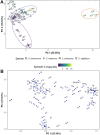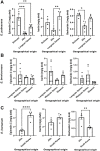HPLC-DAD Fingerprints Combined With Multivariate Analysis of Epimedii Folium From Major Producing Areas in Eastern Asia: Effect of Geographical Origin and Species
- PMID: 34899314
- PMCID: PMC8662750
- DOI: 10.3389/fphar.2021.761551
HPLC-DAD Fingerprints Combined With Multivariate Analysis of Epimedii Folium From Major Producing Areas in Eastern Asia: Effect of Geographical Origin and Species
Abstract
The growth location and plant variety may influence the active components and biological activities of plants used in phytomedicine. In this study, nine sets of different Epimedii Folium, from different representative cultivation locations and Epimedium species, were collected for comparison, using HPLC-DAD combined with multivariate analysis. The objective was to investigate the influence of geographical origin and Epimedium species on the quality of Epimedii Folium, and provide applicable guidance for cultivation and quality control of Epimedii Folium. Several Epimedium spp. sets were used to establish the HPLC-DAD fingerprints and 91 peaks (compounds) were selected for the multivariate analysis. Major compounds were analyzed by HPLC-DAD combined with principal component analysis (PCA). HPLC quantitative analysis of known bioactive compounds was performed. Application of PCA to HPLC data showed that Epimedium samples sharing the same geographical origin or species clustered together, indicating that both species and geographical origin have impacts on the quality of Epimedii Folium. The major bioactive flavonoid compounds, epimedin C, icariin and baohuoside I, were identified and quantified. The concentration of bioactive compounds was significantly influenced both by species and geographical origin. E. sagittatum from Sichuan showed the highest content of bioactive compounds. The results showed that both Epimedium species and geographical origin have strong impact into quality of Epimedii Folium. HPLC data combined with multivariate analysis is a suitable approach to inform the selection of cultivation areas and choose Epimedium spp. most suitable for different geographical areas, resulting in improved quality of Epimedii Folium.
Keywords: Epimedium sp; baohuoside I; epimedin C; high performance liquid chromatography (HPLC); icariin; principal component analysis (PCA).
Copyright © 2021 Li, Lima, Nie, Xu, Liu, Yuan, Chen, Dias and Zhang.
Conflict of interest statement
Author HY was employed by the Jinhuifang Traditional Chinese Medicine Technology Co., Ltd. The remaining authors declare that the research was conducted in the absence of any commercial or financial relationships that could be construed as a potential conflict of interest.
Figures






Similar articles
-
[Determination of 13 chemical components of Epimedii Folium in pharmacopoeia by UPLC method combined with quantitative analysis of multicomponents by single-marker].Zhongguo Zhong Yao Za Zhi. 2024 Feb;49(4):981-988. doi: 10.19540/j.cnki.cjcmm.20231115.103. Zhongguo Zhong Yao Za Zhi. 2024. PMID: 38621905 Chinese.
-
Systematic Quality Evaluation of Epimedium wushanense T. S. Ying Based on Two Quality Control Standards: Total Flavonoid Glycosides and Epimedin C.Chem Biodivers. 2023 Mar;20(3):e202200579. doi: 10.1002/cbdv.202200579. Epub 2023 Feb 20. Chem Biodivers. 2023. PMID: 36740574
-
Holistic quality evaluation method of Epimedii Folium based on NIR spectroscopy and chemometrics.Phytochem Anal. 2024 Jun;35(4):771-785. doi: 10.1002/pca.3327. Epub 2024 Jan 25. Phytochem Anal. 2024. PMID: 38273442
-
Research progress of main components from Epimedii Folium (Yinyanghuo) in the treatment of male reproductive dysfunction and application & development status of Epimedii Folium.J Ethnopharmacol. 2025 Jan 31;340:119161. doi: 10.1016/j.jep.2024.119161. Epub 2024 Nov 27. J Ethnopharmacol. 2025. PMID: 39608617 Review.
-
[Preparation method and pharmacological effect of baohuoside Ⅰ].Zhongguo Zhong Yao Za Zhi. 2018 Sep;43(17):3444-3450. doi: 10.19540/j.cnki.cjcmm.20180702.007. Zhongguo Zhong Yao Za Zhi. 2018. PMID: 30347910 Review. Chinese.
Cited by
-
Diversity and epimedium biotransformation potential of cultivable endophytic fungi associated with Epimedium brevicornum Maxim in the Qinling Mountains, China.Microb Cell Fact. 2025 Apr 3;24(1):80. doi: 10.1186/s12934-025-02698-w. Microb Cell Fact. 2025. PMID: 40181301 Free PMC article.
-
Prenylflavonoids isolated from Epimedii Herba show inhibition activity against advanced glycation end-products.Front Chem. 2024 May 31;12:1407934. doi: 10.3389/fchem.2024.1407934. eCollection 2024. Front Chem. 2024. PMID: 38882216 Free PMC article.
-
Metabolomic and transcriptomic analysis of the flavonoid biosynthesis pathway in Epimedium sagittatum (Sieb. et Zucc.) Maxim. from distinct locations.Front Plant Sci. 2024 Jun 11;15:1424956. doi: 10.3389/fpls.2024.1424956. eCollection 2024. Front Plant Sci. 2024. PMID: 38919822 Free PMC article.
-
A Systematic Study of Yiqi Qubai Standard Decoction for Treating Vitiligo Based on UPLC-Q-TOF/MS Combined with Chemometrics, Molecular Docking, and Cellular and Zebrafish Assays.Pharmaceuticals (Basel). 2023 Dec 11;16(12):1716. doi: 10.3390/ph16121716. Pharmaceuticals (Basel). 2023. PMID: 38139842 Free PMC article.
References
-
- Chinese Pharmacopoeia (2015). Pharmacopoeia of the People's Republic of China. Beijing: China Medical Science Press.
LinkOut - more resources
Full Text Sources
Miscellaneous

